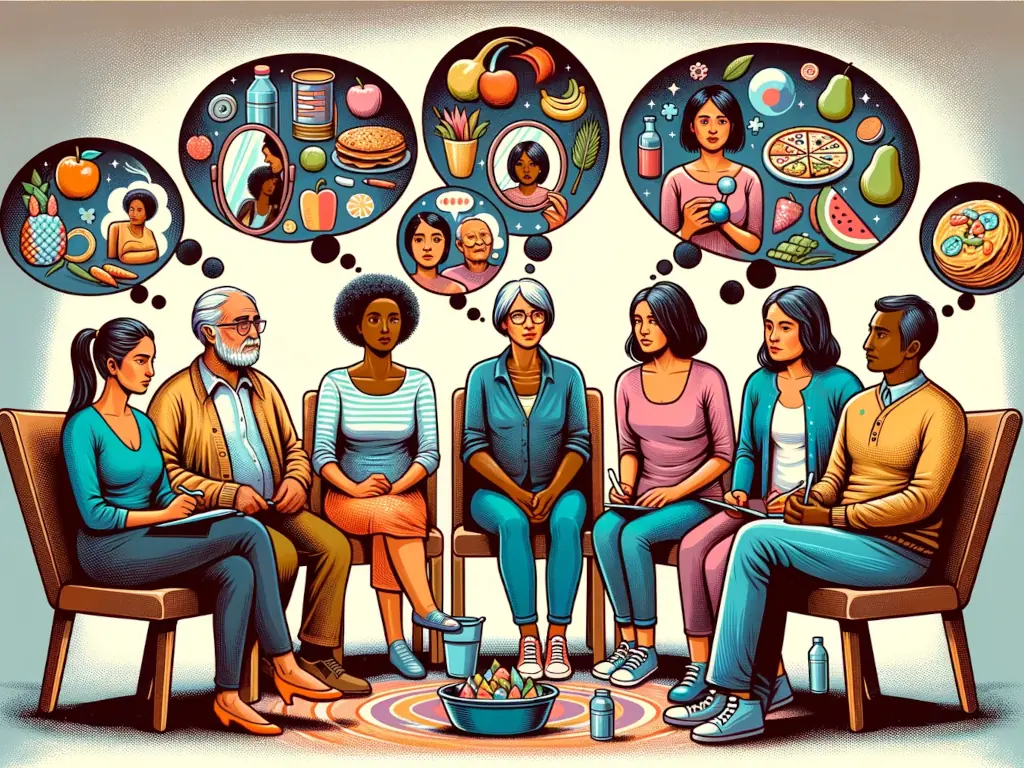Eating disorders are among the most common mental illnesses. They are also among the most deadly. Anorexia nervosa, bulimia nervosa, and binge eating disorder all pose severe health risks to sufferers, as their preoccupation with food intake drives them to unhealthy and prolonged periods of nutritional deprivation or overeating.
Anorexia nervosa is particularly dangerous and has the highest rate of mortality for any mental illness, with 5% of patients dying within 4 years of diagnosis according to the Journal of Eating Disorders. In order to reduce the impact that eating disorders have on the population, it’s important to understand how they take root.
Anxiety disorders are strongly linked with anorexia nervosa and other eating disorders. Read on to learn about this example of psychiatric comorbidity, how Turning Point of Tampa can help treat eating disorders, and to gain an understanding of how effective treatment for eating disorder symptoms can involve treating anxiety as well.
An Introduction to Eating Disorders
Eating disorders represent complex and multifaceted mental health conditions that significantly impact an individual’s relationship with food, body image, and overall well-being. These psychiatric disorders manifest in various forms, each characterized by distinct disordered eating behaviors and psychological underpinnings.
Depression and depressive disorders are often comorbid with eating disorders, as they have some overlapping symptoms. However, eating disorders share more symptoms with anxiety disorders. They often involve excessive worry and anxiety about eating, and these disorders extend beyond mere dietary habits, delving into the realms of self-esteem, identity, and emotional regulation.
Anorexia nervosa, bulimia nervosa, and binge-eating disorder are among the most prevalent eating disorders, each presenting unique challenges for those affected. Here are the basics on each of these eating disorders.
Anorexia Nervosa
Individuals with anorexia nervosa fear gaining weight, leading individuals to restrict their food intake drastically, resulting in severe weight loss. Anorexia affects women more often than men, and is characterized by a fixation on body weight and physical appearance that may arise in part from social influences.
Anorexia Symptoms and Risks
According to Johns Hopkins Medicine, anorexia’s psychiatric symptoms include a distorted body image, extreme anxiety over gaining weight, excessive exercise (sometimes known as orthorexia), and fixation on specific foods. Some individuals with anorexia nervosa
As noted above, anorexia has the highest morbidity rate of any mental illness.
Individuals with anorexia nervosa require managed and supervised weight increase protocols as well as treatment for co-occurring disorders. Contrary to popular opinion, not all people with anorexia are underweight. Atypical anorexia is a variation in which people lose weight through unhealthy methods but do not become underweight as a result.
Bulimia Nervosa
Bulimia nervosa involves a cycle of binge eating followed by compensatory behaviors such as vomiting, exercising excessively, or the misuse of laxatives. Bulimia nervosa is similar to anorexia in that it often stems from low self esteem and includes anxiety over appearance and body size, but is differentiated by purging behaviors, most often self induced vomiting.
Bulimia symptoms can occur in people who are overweight, underweight, or in a normal range for their weight.
Bulimia Symptoms and Risks
Bulimic behaviors can have long term health consequences, including tooth decay, throat swelling, facial swelling, and burst blood vessels in the eyes from forceful vomiting. One recognizable sign of Bulimia is called Russell’s sign. It consists of bruising or abrasions to the knuckles, caused by their repeated use to induce vomiting.
Bulimia nervosa is dangerous for the digestive system, and can cause stomach ruptures for people who eat to excess. It can also cause issues with the heart, as the loss of important nutrients degrades its ability to function. Problems with the oral system, including a swollen esophagus and degradation of dental protection.
Binge Eating Disorder
Binge-eating disorder is characterized by recurrent episodes of consuming large quantities of food, often in a short period, accompanied by a sense of loss of control. While many individuals with binge eating disorder share the negative evaluation of their own appearance that characterizes anorexia nervosa, others may not be concerned about their weight or social appearance.
How Anxiety Factors Into Eating Disorders
Underlying these disorders are complex interplays of genetic predisposition, psychological distress, environmental conditioning, and societal risk factors. Genetic predispositions may render some individuals more vulnerable to an eating disorder, while cultural pressures emphasizing thinness and societal standards of beauty contribute to the development and perpetuation of disordered eating patterns.
Furthermore, trauma, interpersonal difficulties, and perfectionism can act as catalysts for the onset of eating disorders. A co-occurring anxiety disorder could arise from the same issues, and make eating disorder treatment more difficult if not properly diagnosed.
Anxiety Symptoms and Eating Disorders
The impact of eating disorders extends far beyond the physical realm. Individuals grappling with these conditions often experience symptoms beyond disordered eating. These symptoms include profound emotional distress, impaired social functioning, and compromised quality of life, all of which are increased risk factors for anxiety. The significant distress imposed by these problems can lead to improper coping skills like those seen in an eating disorder.
The preoccupation with food, weight, and body image becomes all-encompassing, overshadowing other aspects of life and hindering the pursuit of personal and professional goals. These symptoms overlap heavily with the anxiety symptoms of social anxiety disorder, panic disorder, and post traumatic stress disorder.
In many cases, a person’s disordered eating behaviors emerge in part because of a mental illness that is otherwise undiagnosed. Generalized anxiety disorder is just one most common mental illnesses that people with eating disorders face.
How Some Common Anxiety Disorders Can Contribute to Eating Disorders
Anxiety plays a complex role in the development and perpetuation of anorexia nervosa. Individuals grappling with anxiety disorders may use restrictive eating patterns as a maladaptive coping mechanism to regain a sense of control over their lives.
The relentless worries and fears associated with anxiety can manifest in obsessive concerns about body weight and shape, fueling the pursuit of an unrealistic and dangerously thin ideal. Specific phobias and anxiety disorders may contribute in different ways.
Generalized Anxiety Disorder
Generalized Anxiety Disorder (GAD) is the most common mental illness that primarily involves anxiety. Generalized Anxiety Disorder can lead to the development of eating disorders through a combination of psychological, emotional, and behavioral factors. The significant distress that individuals with Generalized Anxiety Disorder experience can pose an obstacle to overcoming both anxiety and eating disorders.
Individuals with Generalized Anxiety Disorder experience persistent and excessive worry about various aspects of their lives, often accompanied by heightened tension and restlessness. This chronic anxiety can manifest in a desire for control, and for some, this control may be sought through rigid eating habits.
The anxiety associated with Generalized Anxiety Disorder can lead to obsessive thoughts about body image, weight, and food. In an attempt to alleviate the overwhelming anxiety, individuals may turn to restrictive eating, binge-eating, or other maladaptive behaviors related to food. The rigid control over food intake can serve as a coping mechanism, providing a temporary sense of relief from the pervasive worries that characterize Generalized Anxiety Disorder.
Moreover, the physiological effects of anxiety on appetite and digestion may further contribute to disordered eating patterns. GAD-induced stress can disrupt normal hunger cues, leading to irregular eating habits and potential weight fluctuations.
Addressing the root causes of anxiety is crucial in treating the combination of GAD and an eating disorder. A multidimensional approach that combines mental health support, nutritional counseling, and behavioral therapy is essential for effective treatment and sustained recovery.
Social Anxiety Disorder
Social Anxiety Disorder (SAD) is another common anxiety disorder. can significantly contribute to the development of eating disorders as individuals grapple with intense fears of negative social evaluation. The overwhelming anxiety in social situations may lead to a heightened focus on appearance and the desire for societal acceptance, triggering body image concerns that lead to an eating disorder.
In an attempt to conform to perceived standards and avoid judgment, individuals with social anxiety may turn to controlling their food intake, engaging in restrictive eating patterns, or developing an unhealthy relationship with meals.
The relationship between social anxiety and eating disorders can take multiple forms, with some patients being restrictive of their diet and others overeating, one of many maladaptive coping skills that can develop in these instances. A patient with an eating disorder may feel that they can deal with both anxiety and body image issues by restricting their food consumption. Patients who engage in overeating but also fear weight gain may fall victim to bulimic symptoms.
Eating behaviors can become a means of coping with the distressing social interactions that trigger anxiety. Achieving a certain body shape may be perceived as a way to gain social approval and reduce feelings of inadequacy (an overlapping symptom with anxiety disorders. Eating disorder diagnoses should take note of these contributing factors, as anxiety disorders like social anxiety disorder can prevent patients from achieving their physical health goals.
Obsessive Compulsive Disorder
Obsessive-Compulsive Disorder (OCD) is another common mental health condition, and is categorized as an anxiety disorder. As defined in the DSM-5 (Diagnostic and Statistical Manual of Mental Disorders, Fifth Edition), obsessive-compulsive disorder is characterized by intrusive, distressing obsessions and accompanying compulsions. Psychiatry research has found obsessive compulsive disorder to increase risk of eating disorders.
Obsessive-compulsive disorder involves time-consuming rituals performed to alleviate anxiety or prevent a feared event. Obsessions are persistent and unwanted thoughts, images, or urges, while compulsions are repetitive behaviors or mental acts. The disorder significantly interferes with daily functioning and can also overlap with an eating disorder. The DSM-5 emphasizes the importance of the obsessions and compulsions causing significant distress or impairment in social, occupational, or other important areas of functioning to meet the criteria for an OCD diagnosis.
OCD and eating disorders frequently coexist. Individuals with OCD may experience obsessive thoughts related to body image, weight, or food contamination fears, leading to compulsive behaviors like strict dietary rituals or unhealthy levels of exercise. The interplay between OCD and eating disorders shows the need for a comprehensive treatment strategy that concurrently addresses both conditions, ensuring a more effective intervention and long-term recovery from both the eating disorder and the obsessive-compulsive symptoms.
Post Traumatic Stress Disorder
Another instance of comorbidity between anxiety and eating disorders centers on post traumatic stress disorder, a condition that emerges in the aftermath of a traumatic experience. Post-traumatic stress disorder (PTSD) can intersect with the development of eating disorders, creating a complex mental health dynamic and creating links between anxiety and eating behaviors.
Those contending with PTSD might adopt unhealthy coping strategies, such as restricting consumption, binge eating, or purging, to regain control or numb emotional pain, and these strategies can develop into a full-fledged eating disorder. Trauma-induced hyperarousal or avoidance can disrupt normal eating patterns, causing irregularities in appetite and consumption. This intricate connection underscores the profound influence of psychological distress on one’s eating-related behaviors, emphasizing the need for comprehensive mental health interventions to address the intricate interplay between trauma, PTSD, and eating disorders.
Treatment For Co-Occurring Anxiety And Eating Disorders
There is an established link between anxiety and eating disorders, including but not limited to the common mental disorders described above. When an eating disorder and an anxiety disorder co-occur, the most effective treatment must address both these issues. One disorder is unlikely to improve while the other continues to fester.
Treating anxiety often begins with addressing a person’s negative evaluation of themself. Eating disorders and anxiety share this risk factor, as both frequently include an inaccurate or exaggerated negative evaluation of the self, or of particular qualities of the self, and so treatment for them when they co-occur includes talk therapy to build a person’s self esteem and reduce their anxiety.
Anxiety treatment can also include the prescription of selective serotonin reuptake inhibitors (SSRIs), serotonin norepinephrine reuptake inhibitors (SNRIs) and tricyclic antidepressants, all of which are also prescribed for depression. Anxiety and eating disorders can both be treated by psychiatric medications like these.
Learning More and Finding Help
The National Eating Disorders Association and The International Journal of Eating Disorders are both great sources for more information on eating disorders and eating disorder treatment. Both frequently address links between eating disorders and anxiety disorders in their publications.
If you or someone you know is struggling with an eating disorder, with or without an accompanying anxiety disorder or other mental health condition, a licensed and certified treatment center like Turning Point of Tampa is the best place to find help.
Sources:







